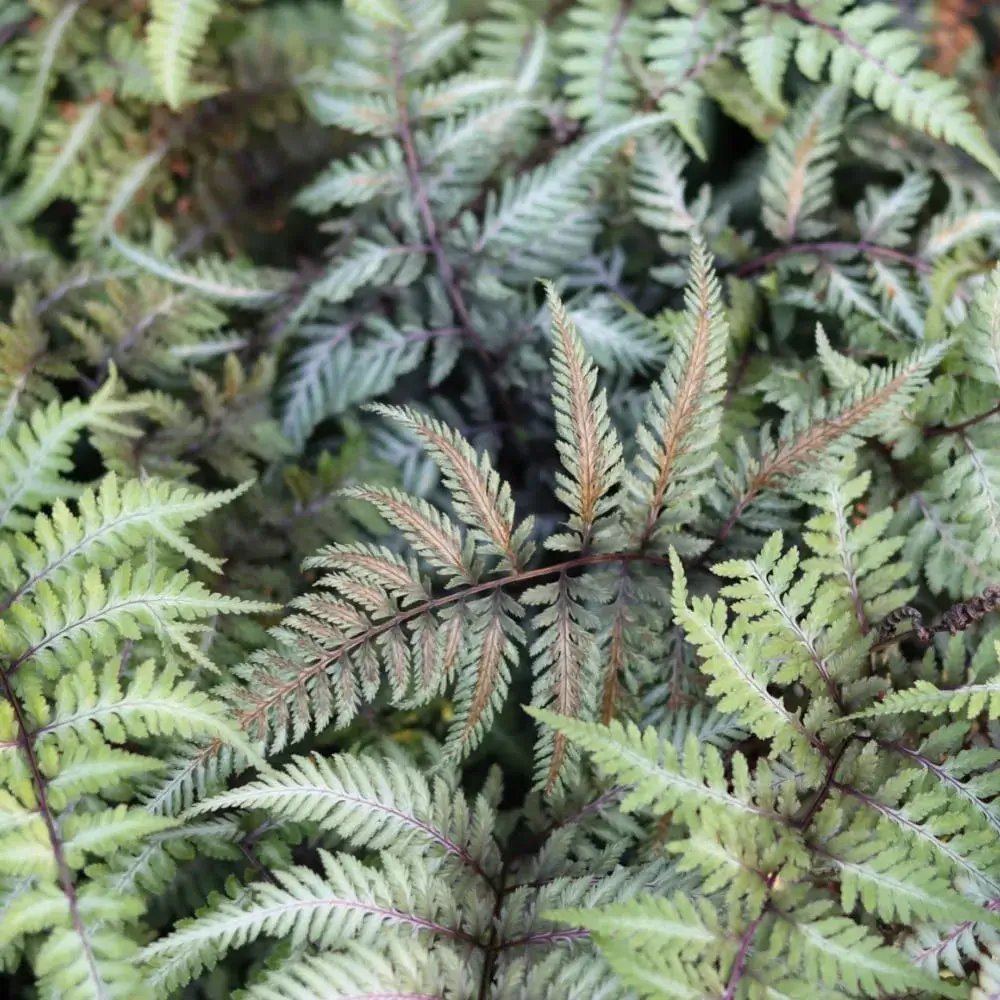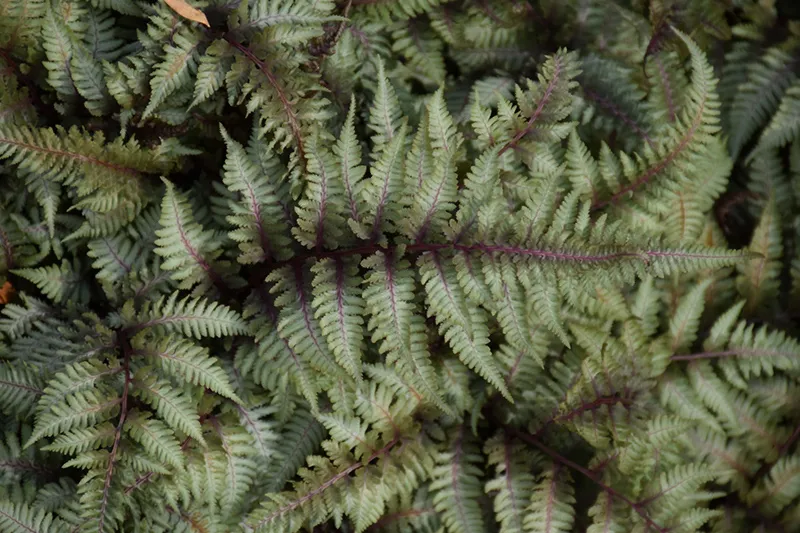Family: Lady Fern
Type: Houseplant
Other Common Name: Crested Japanese Painted Fern

The Japanese Painted Fern is a captivating addition to any garden. Known for its unique color palette, it blends silvery-green fronds with hints of burgundy. This fern thrives in shady areas, making it a perfect choice for adding texture and color under canopies.
Its low maintenance requirements and resistance to pests make it a gardener’s delight. The fern’s delicate appearance belies its hardiness, adapting well to various climates. Ideal for zones 3-8, it can withstand cooler temperatures while maintaining its beauty.
The Japanese Painted Fern’s compact size, typically reaching up to 18 inches, suits small gardens and container plantings. It’s a natural choice for creating serene, woodland-inspired landscapes. Its distinctive foliage provides a striking contrast against darker greens or floral blooms.
Hardiness Zone: 3a-8b
Deer Resistant: Yes
Moisture Preference: Moist to wet
Sun Needs: Partial shade to shade
Growth Rate: Slow
Average Height (feet): 1.5
Average Spread (feet): 2
Average Life Span (years): 15
Form: Arching
Foliage Color: Green
Foliage Shape: Ferny
Incorporating the Japanese Painted Fern into your landscape brings a touch of elegance. Its unique coloration brightens up shady garden spots. Use it to create a focal point or as a complement to other shade-loving plants.
Grouping these ferns can create a lush, textured ground cover. They work beautifully along pathways or under trees. Their compact growth habit makes them ideal for small spaces or as border plants.
For a dynamic garden design, pair them with bright flowers or variegated foliage. Their silvery leaves will highlight the colors of neighboring plants. This fern is perfect for creating depth and contrast in your garden.

In a woodland garden setting, the Japanese Painted Fern truly shines. Its natural affinity for shade and organic, understated elegance complements the woodland aesthetic. Plant it among native shrubs and trees for a tranquil, forest-like ambiance. The fern's unique hues add a touch of whimsy and sophistication to these naturalistic spaces.
In contemporary garden designs, the Japanese Painted Fern adds a soft, organic touch. Its delicate fronds and subtle color variations can soften hard landscaping elements. Use it in minimalist plantings or as an accent in geometric garden layouts. Its modern appeal lies in its simplicity and elegance.
The fern is a charming addition to cottage gardens. Its whimsical fronds and varied hues blend seamlessly with the informal, densely planted style of cottage gardens. Plant it alongside flowering perennials and herbs for a delightful, colorful display. Its texture and form bring a sense of depth and intrigue to these bustling garden spaces.
For a tranquil garden corner, create a small fernery with Japanese Painted Ferns. Mix them with other shade-loving plants for a lush, green retreat. They’re perfect for adding interest to shaded corners or under tree canopies.
Consider using these ferns in container gardens. Their compact size and striking foliage make them excellent for pots and planters. Place them on patios, balconies, or entrances for an elegant touch.
Create a border along walkways or garden beds with these ferns. Their distinctive leaves provide a beautiful, low-growing edge. They’re great for defining spaces without overshadowing other plants.
Select our pre-made garden layouts to create a landscape that’s uniquely yours. Simple, smart, and customizable!
In spring, the Japanese Painted Fern emerges with vibrant, fresh fronds. Its new growth is often more intensely colored, showcasing the fern's unique palette. This is when its silvery sheen is most prominent, catching the light and adding sparkle to the garden.
During summer, the fern's colors deepen, with richer tones of green and burgundy. Its full growth makes it a standout feature in the garden. The fern remains lush and vibrant, providing a cool, calming presence in the summer landscape.
As autumn arrives, the Japanese Painted Fern maintains its elegance. While some ferns may begin to fade, it often retains much of its color and form. It provides a subtle contrast to the fiery autumnal colors of surrounding foliage.
In winter, the fern may die back, especially in colder climates. However, in milder regions, it can retain some foliage, providing winter interest. Its structure and color can be a welcome sight in the otherwise dormant garden.
Hosta 'Patriot'
Heuchera 'Georgia Peach'
Astilbe arendsii 'Fanal'
The Japanese Painted Fern thrives in shady spots, making it perfect for woodland gardens or north-facing areas. Choose locations under trees or beside buildings where it can enjoy protection from harsh sunlight. This setting mimics its natural habitat, encouraging lush growth.
This fern prefers dappled sunlight to full shade. Too much direct sun can scorch its delicate fronds. A spot that receives morning sun and afternoon shade, or light filtered through canopy leaves, is ideal for maintaining its vibrant colors.
Good drainage is crucial for the Japanese Painted Fern. It flourishes in moist, rich, well-draining soil. Adding organic matter like compost can improve soil conditions, providing the nutrients and texture this fern loves. Avoid waterlogged spots to prevent root rot.
Space these ferns about 12-18 inches apart to allow for their mature spread. This spacing ensures each fern has enough room to grow without overcrowding, promoting better air circulation and reducing the risk of disease.
The best time to plant the Japanese Painted Fern is in spring or early fall. Planting during these cooler, moist seasons allows the fern to establish its root system before the extremes of summer or winter.
Plant at the same depth it was in the pot, ensuring the crown is at soil level. Water thoroughly after planting to settle the soil. Mulching around the plant can help retain moisture and regulate soil temperature.
Regular watering is key, especially in dry conditions. Keep the soil consistently moist but not soggy. Reduce watering in winter when the plant’s growth slows down.
Fertilize lightly in spring with a balanced, slow-release fertilizer. Over-fertilizing can harm the fern, so it’s better to err on the side of caution.
Minimal pruning is needed. Remove any dead or damaged fronds in spring to encourage new growth. This also helps maintain the plant’s neat appearance.
As the fern emerges in spring, ensure it has enough moisture. This is also a good time to add a layer of compost or mulch to nourish and protect the plant.
During summer, monitor soil moisture levels and water as needed. The fern should be well-established by now and can handle summer heat with proper care.
In fall, reduce watering and prepare the plant for winter. Clear any debris around the fern to prevent fungal diseases.
In colder regions, the fern may die back. Protect it with a layer of mulch. In milder areas, ensure it's not waterlogged and prune any weather-damaged fronds.
Dryopteris erythrosora 'Apple Court'
Nephrolepsis bisarrata
Polystichum munitum
Yes, this fern is generally deer resistant. Its texture and taste are unappealing to deer, making it a great choice for gardens in deer-prone areas.
It’s a moderately fast grower. With proper care, you can expect it to reach its full size in a couple of seasons, adding a few inches each year.
Absolutely! It can thrive indoors with adequate humidity and light. Place it in a room with bright, indirect light and ensure the air isn’t too dry for best results.
Sign up below to get exclusive deals, discounts, and new plant collections—delivered straight to your inbox! Plus, stay inspired with the latest gardening tips, landscaping trends, and DIY garden ideas. Start growing with us today!
A big thank you for subscribing to the PBN Design newsletter.
We're thrilled to have you join our community. Get ready for exciting updates, insightful content, and more delivered straight to your inbox.
Stay tuned!
Go backA big thank you for subscribing to the PBN Design newsletter.
We're thrilled to have you join our community. Get ready for exciting updates, insightful content, and more delivered straight to your inbox.
Stay tuned!
Go back